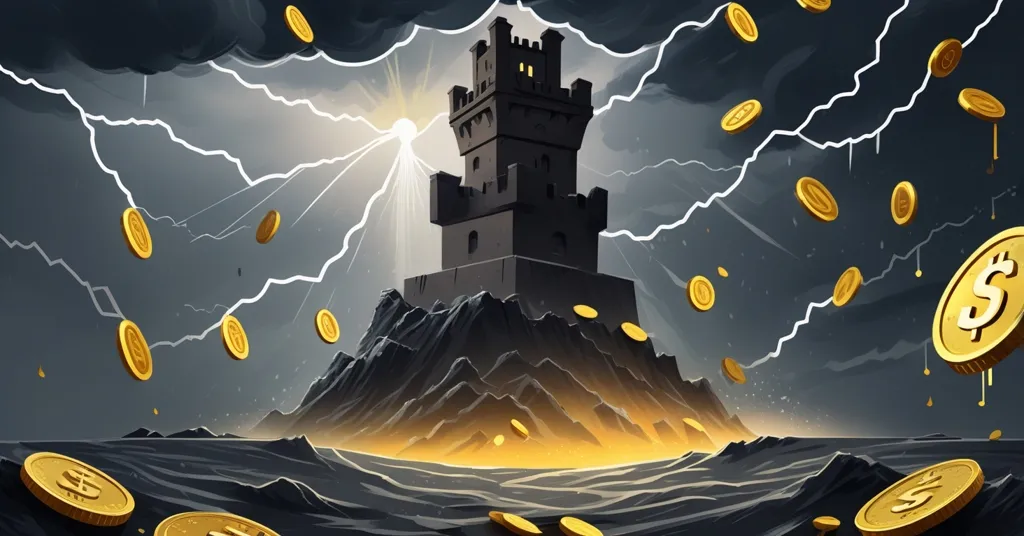Solana Struggles as Mutuum Finance Presale Rakes in $19M with 400% ROI Hype

Crypto Market Turbulence: Solana Stumbles as Mutuum Finance Sparks Presale Frenzy
The crypto market is a battlefield of innovation and volatility, and right now, Solana (SOL) is taking heavy hits with persistent network issues and price stagnation, failing to ride the recovery wave. Meanwhile, a newcomer, Mutuum Finance (MUTM), is stealing the spotlight with a presale haul of $19 million, promising massive returns and a fresh DeFi ecosystem. Let’s unpack this shift from a struggling giant to a hyped underdog, with a critical eye on both.
- Solana’s Struggles: Network congestion and price woes keep SOL from capitalizing on market rebounds.
- Mutuum Finance Buzz: Presale success with $19M raised from over 18,000 investors.
- ROI Potential: MUTM tokens priced at $0.035 now, targeting a launch price of $0.06 for over 400% returns.
Solana’s Downward Spiral: Scalability Woes in 2023
Solana has been a darling of the layer-1 blockchain scene, often hyped as an “Ethereum killer” thanks to its blistering transaction speeds and low costs. Built on a unique consensus mechanism called Proof of History, SOL promised scalability that could handle thousands of transactions per second—think of it as a supercomputer designed to outpace the competition. But here’s the rub: when too many users pile in, it’s like that supercomputer overheating. Network congestion has been Solana’s Achilles’ heel, with infamous outages dating back to September 2021, when a bot-driven DDoS attack on a decentralized exchange (DEX) brought the chain to its knees for nearly 17 hours. Fast forward to 2023, and despite upgrades like the QUIC protocol and fee prioritization to manage transaction loads, slowdowns and failures during peak usage persist. This isn’t just a technical glitch; it’s a confidence crusher. Investors watch as SOL’s price languishes, unable to catch the tailwind of broader market upticks. For those new to the game, network congestion means the blockchain can’t process transactions fast enough, leading to delays or outright failures—imagine a toll booth with a mile-long backup and no way through.
But Solana’s troubles aren’t just about tech. Sentiment drives crypto markets, and repeated stumbles have left some questioning whether SOL can deliver on its lofty promises. Developer activity remains strong, with a vibrant ecosystem of NFTs and DeFi protocols, yet each outage chips away at trust. Compare this to Ethereum, which faced similar growing pains years ago but shored up reliability over time. Solana’s current path raises a glaring question: can it prioritize user experience and decentralized node distribution over pure speed, or will it keep tripping over its own ambition? As a Bitcoin maximalist, I can’t help but smirk—Bitcoin’s simplicity and battle-tested security don’t get bogged down in these layer-1 dramas. Still, Solana’s potential isn’t dead; these are growing pains, not a death sentence. The question is whether investors have the patience to wait for a turnaround.
Mutuum Finance: Hype Machine or Hidden Gem?
With Solana stuck in the mud, restless capital is flowing to untested waters, and Mutuum Finance (MUTM) is making a splash. This presale project has pulled in a staggering $19 million from 18,200 investors, a clear sign of market hunger for the next big thing. Currently in Phase 6 of its presale, MUTM tokens are going for a low entry price of $0.035, with over 95% of this batch sold out and a bump to $0.040 looming in the next phase. The real draw? A projected launch price of $0.06 per token, dangling the carrot of over 400% returns for early backers. For the uninitiated, a presale is like investing in a startup before it goes public—you snag tokens at a discount, betting on a value spike when they hit exchanges. It’s a high-stakes gamble, but MUTM’s numbers and buzz have caught plenty of eyes as a potential recovery play in a market where giants like Solana are faltering, as noted by experts analyzing recovery opportunities in crypto.
What’s fueling this frenzy? MUTM isn’t just selling tokens; it’s pitching an ecosystem. A cornerstone of their plan is an over-collateralized stablecoin, pegged 1:1 to the U.S. dollar, designed to bring stability to their platform. If you’re new to this, a stablecoin aims to maintain a steady value, unlike volatile assets like Bitcoin or Ethereum, often by tying itself to a fiat currency like the USD. Over-collateralization means users lock up more value in assets than the stablecoin they mint—say, depositing $150 worth of crypto to create $100 of stablecoin—as a buffer against price drops. Think of it as a bank requiring a bigger security deposit to ensure the system stays solvent during market crashes. MUTM’s stablecoin will power a borrowing marketplace, a DeFi (decentralized finance) hub where users can lend and borrow crypto assets without the wild swings that often turn DeFi into a heart-attack machine. For clarity, DeFi refers to financial services—think lending, trading, or savings—built on blockchain tech, cutting out middlemen like banks. Stability in crypto sounds like a pipe dream, but if MUTM pulls it off, it could lure in yield farmers and retail investors looking for safer plays.
They’re also waving the trust flag with a full audit of their core borrowing and lending contracts by Halborn Security, a respected name in blockchain cybersecurity. Audits are deep dives into a project’s code to spot bugs or exploits—think of them as a health check before surgery. Given DeFi’s ugly history of hacks and rug pulls, where millions vanish overnight, this step matters. It’s not a bulletproof shield (just ask projects that got hacked post-audit), but it’s more than many presales bother with in their race to cash in. MUTM’s focus hints at an awareness of investor wariness—a good sign in a space littered with broken promises.
Hype vs. Reality: A Brutal Reality Check
Before we get carried away with MUTM fever, let’s slam on the brakes. A projected 400% return sounds like a fantasy, but let’s be blunt—most presales crash harder than a drunk driver. The crypto graveyard is full of shiny ICOs and token sales from 2017-2018, with over 80% failing to deliver anything beyond empty wallets. MUTM’s hype is just that until those tokens hit exchanges and face real market pressure. What’s their team’s track record? How does their borrowing marketplace stack up against heavyweights like Aave or Compound? And don’t get me started on stablecoins—regulatory scrutiny is a guillotine waiting to drop, as Tether’s legal battles and the 2022 TerraUSD (UST) collapse painfully showed. Over-collateralization might cushion some blows, but if the collateral assets tank, liquidation spirals can still gut users. MUTM hasn’t detailed their exact over-collateralization ratio (is it 150%? 200%?) or liquidation mechanics, leaving big question marks for savvy investors.
On the flip side, let’s not bury Solana just yet. It’s still a top-tier blockchain with a massive developer community and real use cases, from NFT marketplaces to DeFi protocols. Its transaction speed and cost still beat Ethereum in many scenarios—SOL can process up to 65,000 transactions per second compared to Ethereum’s 15-30, though Ethereum’s layer-2 solutions are closing the gap. Solana’s issues are fixable, and betting against it might be like shorting Bitcoin in its early, buggy days. History shows that layer-1 chains with strong ecosystems often recover if they adapt—Ethereum did. Solana’s current upgrades could be the turning point, even if investor patience is wearing thin.
Now, wearing my Bitcoin maximalist hat, I’ve got to say: all this altcoin drama and presale gambling is a sideshow. Bitcoin is the true north of decentralization, a store of value with unmatched security forged over a decade of battle scars. It doesn’t need to play in DeFi sandboxes or promise 400% returns—its beauty is doing one thing damn well: being money without a master. Projects like MUTM might fill niches in lending or stablecoin experiments, areas Bitcoin wisely avoids, but they’re speculative bets, not the foundation of this revolution. BTC remains king, and no amount of presale hype changes that. Still, I’ll concede that the crypto space thrives on innovation, and underdogs can drive adoption in ways Bitcoin doesn’t. MUTM could be a calculated punt for those with risk tolerance—just don’t bet the farm.
Market Mood: Cyclical Shifts and Speculative Bets
The broader context here is a market still licking its wounds from the 2022 bear cycle, where risk aversion battles FOMO (fear of missing out). When established players like Solana lag, capital chases momentum, and presales like MUTM become lightning rods for speculative cash. It’s a classic crypto pattern—giants stumble, underdogs rise, and the cycle repeats. Whether MUTM delivers or flops, it’s a snapshot of how this space operates: a Wild West of innovation, risk, and raw ambition. Solana’s fight to regain footing and MUTM’s bid for relevance are two sides of the same volatile coin. As Bitcoiners, we watch from the sidelines, rooting for decentralization while knowing most of these experiments won’t dethrone the champ. Are you betting on recovery plays or sticking with proven resilience? Time, as always, will be the ultimate judge.
Key Takeaways and Questions Answered
- What’s driving Solana (SOL) network issues in 2023?
Solana’s persistent congestion stems from overwhelming transaction volumes that its Proof of History consensus can’t handle at peak times, leading to outages like the 2021 DDoS incident, eroding trust despite ongoing upgrades. - Why is Mutuum Finance (MUTM) gaining traction as a presale project?
MUTM has raised $19 million from over 18,000 investors, with tokens at $0.035 promising over 400% returns at a $0.06 launch price, positioning it as a speculative recovery play amid Solana’s struggles. - How does Mutuum Finance aim to innovate in DeFi?
It’s developing an over-collateralized stablecoin pegged to the USD for stability, paired with a borrowing marketplace to enable lending and borrowing with lower volatility, targeting DeFi users seeking safer options. - Are presale projects like Mutuum Finance a reliable investment?
Despite audits by Halborn Security, presales are high-risk—most fail due to market pressures, scams, or regulatory hurdles. Hype doesn’t equal delivery, so caution is non-negotiable. - Should Bitcoin maximalists care about altcoins like MUTM?
Bitcoin reigns for decentralization and security, but altcoins like MUTM can explore DeFi niches BTC doesn’t touch. They’re speculative side bets, not rivals to the king of crypto. - What can Solana learn from past blockchain scalability failures?
Solana must prioritize user experience and decentralized infrastructure over raw speed, much like Ethereum did, to rebuild trust and sustain growth through robust, lasting solutions.



